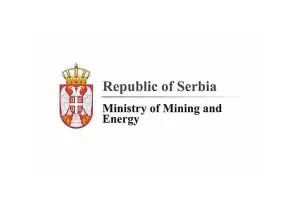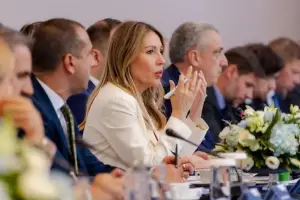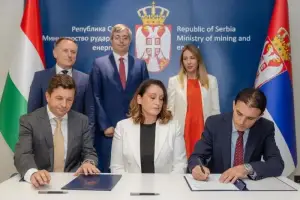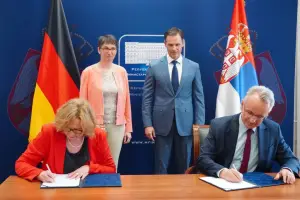- Serbia
Get to know Serbia
- Citizens
Culture and science
Health services
Pension and disability insurance
- Business
Employment
Economy
- Media
- Government
- Contact
Keep in touch
Contact form
Back
Keepin touch
Whether you have a question, comment, suggestion or any problem in the purview of the government, send us your message and we will try to respond as soon as possible. If your problem is not in our purview, we will forward your message to the relevant institution.
Q:
A:
October foreign trade up year-on-year
Belgrade,
28 November 2008
The Serbian Statistics Office said that Serbia’s total foreign trade in the period January-October 2008 amounted to $29,505.6 million, rising 34.1% against the same period in 2007.
Exports totalled $9,551.5 million, surging 33.1% from a year earlier, while imports rose 34.6% to nearly $19,954.2 million.
Expressed in euros, exports increased to €6,335.9 million, or by 19.4%, while imports went up 20.8% and amounted to €13,238.6 million against the same period in 2007.
The trade deficit was $10,402.6 million, a 36% increase from the same period a year earlier. Expressed in euros, the deficit amounted to €6,902.7 million, or rose by 22.2% against the same period last year.
Exports-to-imports ratio was 47.9%, down from 48.4% from a year earlier.
The increase in imports in this period was due to the import of energy resources.
The most imported items were vehicles, iron, steel, copper and equipment.
The increase in exports was mainly due to the results of privatisation and company restructuring, as well as signed and ratified agreements on free trade with signatories of the Stability Pact.
Another factor causing the increase in exports is the surplus in food exchange (grains and grain products export stood at $277 million, fruit and vegetable export stood at $409 million), as well as the signed Agreement with the EU allowing Serbian textile products preferential exchange rates.
The most exported items were intermediate goods, accounting for 65.8% ($6,288.2 million) of overall exports, followed by consumer goods, which made up 26% ($2,487 million) and equipment, making up 8.1% ($776.2 million) of total exports.
Imports were also dominated by intermediate goods 61.3% ($12,231.4 million), consumer goods 22.1% ($4,400.8 million) and equipment 16.6% ($3,321.9 million) of overall imports.
Major importers of Serbian goods were Bosnia-Herzegovina ($1,159.6 million), Montenegro ($1,138.2 million) and Germany ($1,006.3 million).
The largest exporters to Serbia were Russia ($3,059.2 million), Germany ($2,352.1 million) and Italy ($1,906 million).
The greatest foreign trade was recorded in commerce with the EU, which accounted for more than half of total trade.
The foreign trade surplus was realised in commerce with Bosnia-Herzegovina, Macedonia and Montenegro. The largest trade deficit was in commerce with Russian, due to the import of oil and gas.
The second most important partner was CEFTA countries, with which a surplus of $1,607.2 million was realised as a result of the export of iron and steel as well as agricultural products.
According to the Standard International Trade Classification, iron and steel have the largest share of exports ($1,349 million), coloured metals ($651 million), garments ($440 million), metal products ($407 million) and fruit and vegetables ($409 million). The export in these five sections made up 34.1% of overall export.
Expressed in euros, exports increased to €6,335.9 million, or by 19.4%, while imports went up 20.8% and amounted to €13,238.6 million against the same period in 2007.
The trade deficit was $10,402.6 million, a 36% increase from the same period a year earlier. Expressed in euros, the deficit amounted to €6,902.7 million, or rose by 22.2% against the same period last year.
Exports-to-imports ratio was 47.9%, down from 48.4% from a year earlier.
The increase in imports in this period was due to the import of energy resources.
The most imported items were vehicles, iron, steel, copper and equipment.
The increase in exports was mainly due to the results of privatisation and company restructuring, as well as signed and ratified agreements on free trade with signatories of the Stability Pact.
Another factor causing the increase in exports is the surplus in food exchange (grains and grain products export stood at $277 million, fruit and vegetable export stood at $409 million), as well as the signed Agreement with the EU allowing Serbian textile products preferential exchange rates.
The most exported items were intermediate goods, accounting for 65.8% ($6,288.2 million) of overall exports, followed by consumer goods, which made up 26% ($2,487 million) and equipment, making up 8.1% ($776.2 million) of total exports.
Imports were also dominated by intermediate goods 61.3% ($12,231.4 million), consumer goods 22.1% ($4,400.8 million) and equipment 16.6% ($3,321.9 million) of overall imports.
Major importers of Serbian goods were Bosnia-Herzegovina ($1,159.6 million), Montenegro ($1,138.2 million) and Germany ($1,006.3 million).
The largest exporters to Serbia were Russia ($3,059.2 million), Germany ($2,352.1 million) and Italy ($1,906 million).
The greatest foreign trade was recorded in commerce with the EU, which accounted for more than half of total trade.
The foreign trade surplus was realised in commerce with Bosnia-Herzegovina, Macedonia and Montenegro. The largest trade deficit was in commerce with Russian, due to the import of oil and gas.
The second most important partner was CEFTA countries, with which a surplus of $1,607.2 million was realised as a result of the export of iron and steel as well as agricultural products.
According to the Standard International Trade Classification, iron and steel have the largest share of exports ($1,349 million), coloured metals ($651 million), garments ($440 million), metal products ($407 million) and fruit and vegetables ($409 million). The export in these five sections made up 34.1% of overall export.
-
 Belgrade, 11 August 2025
Belgrade, 11 August 2025Support for agricultural projects worth RSD 750 million
-
 Belgrade, 21 July 2025
Belgrade, 21 July 2025Construction of oil pipeline with Hungary to begin early next year
-
 Belgrade/Athens, 17 July 2025
Belgrade/Athens, 17 July 2025Serbia continues to align with EU in field of energy
-
 Kostolac, 14 July 2025
Kostolac, 14 July 2025First solar power plant Petka in Kostolac put into trial operation
-
 Belgrade, 11 July 2025
Belgrade, 11 July 2025Potential for improving cooperation with Belarus in many areas
-
 Požega, 5 July 2025
Požega, 5 July 2025Section of Pakovraće - Požega highway officially opened
-
 Belgrade, 2 July 2025
Belgrade, 2 July 2025Technical specifications defined for Serbia-Hungary oil pipeline
-
 Belgrade, 30 June 2025
Belgrade, 30 June 2025IMF confirms Serbia successfully implementing all agreed reforms
-
 Belgrade, 27 June 2025
Belgrade, 27 June 2025Double Taxation Avoidance Agreement with Germany signed
-
 Kostolac, 25 June 2025
Kostolac, 25 June 2025Construction of Kostolac wind farm nearing completion
